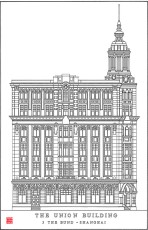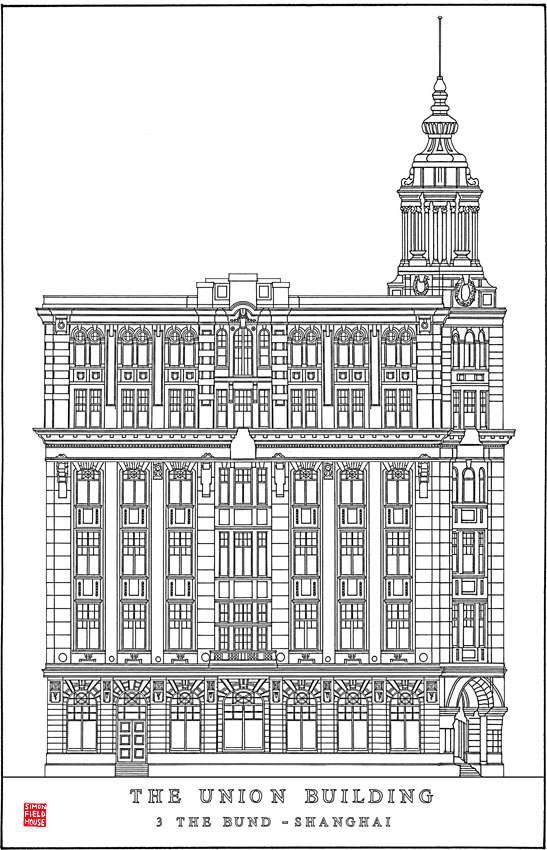
The Union Building - Shanghai
No. 3 The Union Building is a building on the Bund in Shanghai, China. It is was formerly No. 4.
Completed in 1916, the building was used by a number of insurance companies. The six-storey building was the first work in Shanghai of P&T Architects and Surveyors (Palmer & Turner), and was the first building in Shanghai to use a steel structure. The building occupied 2241 square metres, with a floor area of 13760 square metres. Because it had a narrow frontage onto the Bund, the main door was located on the adjacent Guangdong Road.
The building is in Neo-Renaissance style with a symmetrical facade, but with some Baroque style details. The roof features a domed corner pavilion.
In 1937, the Japanese Imperial Army threatened Shanghai. Being unable to indemnify war damages, the insurance companies had their assets frozen. The Union Bank then purchased building. In 1949 the Union Bank evacuated from Shanghai in the wake of the Communist takeover. From 1953 the building was used by the Shanghai Civil Architecture and Design Institute. In 1997 a private equity fund from Singapore purchased the building, and in 2004 converted it to a 'high-class' shopping centre, called 'Three on the Bund'.
Baroque style details
According to the Oxford English Dictionary, the word baroque is derived from the Portuguese word "barroco", Spanish "barroco", or French "baroque", all of which refer to a "rough or imperfect pearl", though whether it entered those languages via Latin, Arabic, or some other source is uncertain.[3] A century ago, the Encyclopedia Britanica 11th edition, thought the term was derived from the Spanish barrueco, a large, irregularly-shaped pearl, and it was for a time confined to the craft of the jeweller. Others derive it from the mnemonic term "Baroco" denoting, in logical Scholastica, a supposedly laboured form of syllogism.[5] In informal usage, the word baroque can simply mean that something is "elaborate", with many details, without reference to the Baroque styles of the seventeenth and eighteenth centuries.
The word "Baroque", like most periodic or stylistic designations, was invented by later critics rather than practitioners of the arts in the 17th and early 18th centuries. It is a French transliteration of the Portuguese phrase "pérola barroca", which means "irregular pearl", and natural pearls that deviate from the usual, regular forms so they do not have an axis of rotation are known as "baroque pearls".
The term "Baroque" was initially used with a derogatory meaning, to underline the excesses of its emphasis. In particular, the term was used to describe its eccentric redundancy and noisy abundance of details, which sharply contrasted the clear and sober rationality of the Renaissance. Although it was long thought that the word as a critical term was first applied to architecture, in fact it appears earlier in reference to music, in an anonymous, satirical review of the première in October 1733 of Rameau's Hippolyte et Aricie, printed in the Mercure de France in May 1734. The critic implied that the novelty in this opera was "du barocque", complaining that the music lacked coherent melody, was filled with unremitting dissonances, constantly changed key and meter, and speedily ran through every compositional device.
Modern usage
In modern usage, the term "Baroque" may still be used, usually pejoratively, describing works of art, craft, or design that are thought to have excessive ornamentation or complexity of line, or, as a synonym for "Byzantine", to describe literature, computer software, contracts, or laws that are thought to be excessively complex, indirect, or obscure in language, to the extent of concealing or confusing their meaning.
The word was first rehabilitated by the Swiss-born art historian, Heinrich Wölfflin (1864–1945) in his Renaissance und Barock (1888); Wölfflin identified the Baroque as "movement imported into mass," an art antithetic to Renaissance art. He did not make the distinctions between Mannerism and Baroque that modern writers do, and he ignored the later phase, the academic Baroque that lasted into the 18th century. Writers in French and English did not begin to treat Baroque as a respectable study until Wölfflin's influence had made German scholarship pre-eminent.
